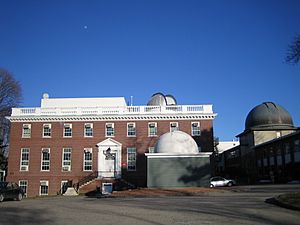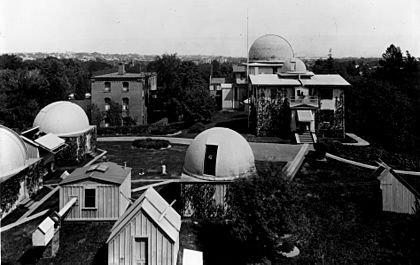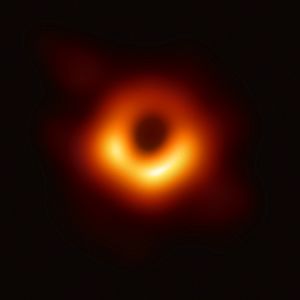Harvard–Smithsonian Center for Astrophysics facts for kids
 |
|

CfA Headquarters in Cambridge, Massachusetts
|
|
| Abbreviation | CfA |
|---|---|
| Established | 1973 |
| Purpose | Research in astronomy, astrophysics, Earth, and space sciences |
| Headquarters | 60 Garden Street, Cambridge, Massachusetts, United States |
|
Director
|
Michael McCarthy (interim) |
|
Staff
|
850+ |
|
Formerly called
|
Harvard-Smithsonian Center for Astrophysics |
The Center for Astrophysics | Harvard & Smithsonian (CfA) is a special place where scientists study space! It's a research center created by two big names: the Harvard College Observatory and the Smithsonian Astrophysical Observatory.
The CfA started in 1973 in Cambridge, Massachusetts. Its main goal is to explore the universe. Scientists here study astronomy (stars, planets, galaxies), astrophysics (the physics of space), Earth, and space sciences. They also work on teaching people about science.
The CfA helps build and run over 15 different observatories. These include powerful telescopes on the ground and in space. Some famous ones are the Giant Magellan Telescope (which is still being built) and the Chandra X-ray Observatory. Chandra is one of NASA's most important space telescopes.
With more than 850 scientists and engineers, the CfA is one of the biggest space research centers in the world. Their work has led to amazing discoveries. These include finding many exoplanets (planets outside our solar system) and even taking the first picture of a black hole!
The CfA also helps other scientists around the world. For example, their Astrophysics Data System (ADS) is a huge online library of astronomy and physics papers that almost everyone uses. The center changed its name in 2018 to show that it's a joint effort between Harvard University and the Smithsonian Institution.
Contents
Discovering the Universe: The CfA's Story
The Center for Astrophysics | Harvard & Smithsonian isn't a separate company. It's a special partnership between Harvard University and the Smithsonian Institution. This partnership began on July 1, 1973. The idea was to bring together the research of the Harvard College Observatory (HCO) and the Smithsonian Astrophysical Observatory (SAO). They wanted to work as one team, led by a single director, all in the same buildings in Cambridge, Massachusetts.
This means the CfA's story is also the story of HCO and SAO. These two groups have been making big discoveries in astronomy for over 300 years, even before the CfA officially started.
The Smithsonian Astrophysical Observatory: A Look Back
The Smithsonian Astrophysical Observatory (SAO) was started on March 1, 1890. It was founded by Samuel Langley, who was the third leader of the Smithsonian Institution. SAO's first main job was to "record the amount and character of the Sun's heat."
Charles Greeley Abbot became SAO's first director. His team used solar telescopes to measure the Sun's brightness every day. They studied different parts of the light spectrum. This work helped Abbot improve how we measure the Sun's energy. He also accidentally found out that the Sun's brightness can change over time. SAO's early focus on the Sun might even be why the Smithsonian's logo, designed in 1965, looks like a sunburst!
In 1955, SAO moved from Washington, D.C., to Cambridge, Massachusetts. This was to work more closely with the Harvard College Observatory (HCO). Fred Lawrence Whipple, who led Harvard's Astronomy Department, became the new director of SAO. So, SAO and HCO were already working together 18 years before the CfA was officially created.
When SAO moved to Harvard, its research grew a lot. After Sputnik (the first human-made satellite) was launched in 1957, SAO helped create a worldwide network to track satellites. They worked with the United States Air Force on a project called Space Track.
Later, with the creation of NASA and during the "Space Race," SAO played a big part. They helped develop telescopes in orbit and large telescopes on the ground. They also did important work in theoretical astrophysics (using math and physics to understand space) and used computers to solve space problems.
The Harvard College Observatory: A Rich Past


The Harvard College Observatory (HCO) was founded in 1839. This happened partly because people were very interested in astronomy after Halley's Comet returned in 1835. William Cranch Bond was named the "Astronomical Observer to the University."
For its first four years, the observatory was small, with just a few telescopes. In 1847, a much bigger telescope opened: the 15-inch "Great Refractor." It was built on Observatory Hill in Cambridge, Massachusetts, where it still stands today. This telescope was the largest in the United States from 1847 to 1867.
William Bond and photographer John Adams Whipple used the Great Refractor to take the first clear photos of the Moon. They even won an award for it in London in 1851! Bond and his son, George Phillips Bond, also used it to discover Hyperion, one of Saturn's moons.
From 1877 to 1919, Edward Charles Pickering led the observatory. During this time, HCO became famous for studying the light from stars and measuring their brightness. They even set up an observing station in Peru. Pickering also used new methods to analyze huge amounts of data.
This was when the observatory's famous "Computers" worked there. These were women hired by Pickering to process astronomical data. Important scientists like Williamina Fleming, Annie Jump Cannon, Henrietta Swan Leavitt, Florence Cushman, and Antonia Maury were among them. Today, they are recognized as major figures in science history.
Henrietta Swan Leavitt made a huge discovery. She found a way to measure distances to galaxies by studying certain types of stars called Cepheid variables. This discovery, now called "Leavitt's law," was super important. Later, astronomers like Edwin Hubble used it to show that the Universe is expanding. This was key evidence for the Big Bang model.
After Pickering retired in 1921, Harlow Shapley became the director. During his time, Cecilia Payne-Gaposchkin became the first woman to earn a PhD in astronomy from Radcliffe College (which was near the observatory). In her 1925 thesis, she suggested that stars were mostly made of hydrogen and helium. This idea was thought to be silly at the time, but she was right!
Before the CfA was formed, Donald Howard Menzel and then Leo Goldberg led the observatory. Menzel especially encouraged SAO to move to Cambridge and work more closely with HCO.
The CfA: Working Together for Space Discoveries
The idea for the Center for Astrophysics started when SAO moved to Cambridge in 1955. Fred Lawrence Whipple, who was already leading Harvard's Astronomy Department, also became the new director of SAO. This was an early test of having one leader for both HCO and SAO. For the next 18 years, the two groups worked more and more closely, almost like one big research center.
This joint work officially became the Harvard–Smithsonian Center for Astrophysics on July 1, 1973. George B. Field was chosen as its first director. That same year, a new science journal, the CfA Preprint Series, was created. Also, a CfA/SAO instrument on Skylab (a space station) discovered "coronal holes" on the Sun.
The CfA's founding also happened at the start of X-ray astronomy. This new field of study was largely led by CfA scientists. Riccardo Giacconi, often called the "father of X-ray astronomy," moved his research group to SAO in 1973. His group later launched the Einstein Observatory in 1976. This was the first telescope that could take X-ray pictures. They also led the creation of the Chandra X-ray Observatory. Chandra is still the most powerful X-ray telescope ever built and is run by the CfA's Chandra X-ray Center. Giacconi later won the Nobel Prize in Physics in 2002 for his amazing work in X-ray astronomy.
Soon after the Einstein Observatory launched, the CfA's Steven Weinberg won the Nobel Prize in Physics in 1979 for his work on how two forces in nature are related.
The next ten years saw the start of the important CfA Redshift Survey. This was the first attempt to map the large-scale structure of the Universe. Irwin I. Shapiro became the director in 1982 and stayed until 2004. During his time, the CfA expanded its observatories around the world. These included the Fred Lawrence Whipple Observatory, the 6.5-meter Multiple Mirror Telescope (MMT), and the launch of Chandra in 1999.
Discoveries during this time included important work on Supernova 1987A (a huge star explosion), the "CfA2 Great Wall" (which was then the largest known structure in the Universe), and the first strong proof of an exoplanet.
The 1980s also saw the CfA play a special role in the history of computer science and the internet. In 1986, SAO started developing SAOImage, one of the first computer programs that was shared publicly. Its newer version, DS9, is still the most used program for viewing astronomical images today. Scientists at the CfA also began working on the Astrophysics Data System (ADS). This became one of the world's first online databases for research papers. By 1993, the ADS was making the first regular connections between databases across the Atlantic Ocean, which is a basic part of how the internet works today.
The CfA Today: Exploring the Cosmos

What Scientists Study at the CfA
Charles R. Alcock became the third director of the CfA in 2004. Today, he leads one of the biggest and most active astronomy centers in the world. It has over 850 staff members and a budget of more than $100 million each year.
The Harvard Department of Astronomy, which is part of the CfA, has about 60 PhD students, over 100 postdoctoral researchers (scientists who have finished their PhD), and about 25 undergraduate students from Harvard College. SAO also has a popular summer internship program for college students. The CfA believes that about 10% of all professional astrophysicists in the United States have spent some time working or studying there.
The CfA is a main partner in running many observatories. These include the Fred Lawrence Whipple Observatory, the Submillimeter Array, the MMT Observatory, the South Pole Telescope, and VERITAS. The CfA's plan for 2019–2024 includes helping to build the Giant Magellan Telescope.
Besides the Chandra X-ray Observatory, the CfA is also very involved in several space-based observatories. These include the Parker Solar Probe, the Kepler space telescope, the Solar Dynamics Observatory (SDO), and Hinode. SAO also played a big role in the Lynx X-ray Observatory project. If launched, Lynx would be the most powerful X-ray observatory ever built, much better than Chandra.
SAO is one of the 13 groups involved in the Event Horizon Telescope project. The CfA hosts the center where they manage the telescope's operations. In 2019, this project showed the world the first direct image of a black hole. This was a huge success for both observational astronomy (looking at space) and theoretical astrophysics (using math to understand space). Combining these two areas has been a main focus for the CfA since it started.
In 2018, the CfA changed its official name to "Center for Astrophysics | Harvard & Smithsonian." This was to highlight that it's a unique partnership between Harvard University and the Smithsonian Institution. Today, about 70% of the CfA's money comes from NASA, 22% from the Smithsonian, and 4% from the National Science Foundation. The rest comes from other groups and donations.
How the CfA is Organized
The research at the CfA is divided into six main areas and seven special research centers:
Science Areas at the CfA
- Atomic and Molecular Physics (AMP)
- High Energy Astrophysics (HEA)
- Optical and Infrared Astronomy (OIR)
- Radio and Geoastronomy (RG)
- Solar, Stellar, and Planetary Sciences (SSP)
- Theoretical Astrophysics (TA)
Special Centers at the CfA
- Chandra X-ray Center (CXC), which runs NASA's Chandra X-ray Observatory
- Institute for Theory and Computation (ITC)
- Institute for Theoretical Atomic, Molecular, and Optical Physics (ITAMP)
- Center for Parallel Astrophysical Computing (CPAC)
- Minor Planet Center (MPC)
- Telescope Data Center (TDC)
- Radio Telescope Data Center (RTDC)
- Solar & Stellar X-ray Group (SSXG)
The CfA also hosts the Harvard University Department of Astronomy. It has large engineering and computer facilities, a Science Education Department, the John G. Wolbach Library, the world's largest database of astronomy and physics papers (ADS), and the world's largest collection of astronomical photographic plates.
Observatories the CfA Helps Run
Telescopes on the Ground
- Fred Lawrence Whipple Observatory
- Magellan telescopes
- MMT Observatory
- Event Horizon Telescope
- South Pole Telescope
- Submillimeter Array
- 1.2-Meter Millimeter-Wave Telescope
- Very Energetic Radiation Imaging Telescope Array System (VERITAS)
Observatories and Probes in Space
- Chandra X-ray Observatory
- Transiting Exoplanet Survey Satellite (TESS)
- Parker Solar Probe
- Hinode
- Kepler
- Solar Dynamics Observatory (SDO)
- Solar and Heliospheric Observatory (SOHO)
- Spitzer Space Telescope
Future Observatories Planned
- Lynx X-ray Observatory
- Giant Magellan Telescope
- Murchison Widefield Array
- Square Kilometer Array
- Pan-STARRS
- Vera C. Rubin Observatory
Images for kids
See also
 In Spanish: Centro de astrofísica Harvard-Smithsonian para niños
In Spanish: Centro de astrofísica Harvard-Smithsonian para niños


